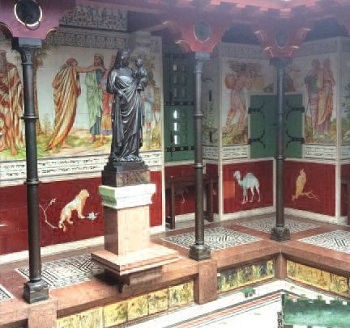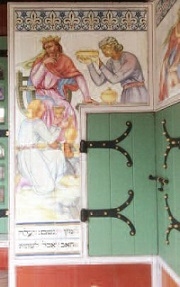A Return to Wales
In the heart of Cardiff, the capital of Wales, sits an impressive castle with enormous grounds, part of the outer walls of which overlooking Victorian, Edwardian and modern day era indoor shopping arcades that have earned the city the name of the "City of Arcades."
Of particular interest to Jewish visitors to Cardiff Castle—one of Wales leading tourist attractions—is a phenomenal roof garden, the walls of which depict colorful scenes from the Old Testament story of Elijah, with rows of Hebrew lettering under each scene.
Upon entering the roof garden, the sight is absolutely breathtaking, in more ways than one as it is necessary to climb scores of very narrow, circular concrete stairs to actually get up there. During my visit there were no plants anywhere on the roof garden but the decorative tiles, which tell a biblical tale, were more than sufficient to elicit a wow factor of a very special kind.
In fact, had all the pots been full of greenery, it would have hidden much of what one sees on the lower levels of the walls which are covered in animals and birds, the background to each panel a deep orange, making each figure stand out even more.
Created in the Bute Tower of the castle in the 1870s, the roof garden consists of a sunken courtyard, in the center of which sits an intricate tiered fountain encircled by decorative metal plant holders, overlooked by an impressive statue of Madonna and child created by the Italian sculptor Ceccardo Fucigna. The courtyard is surrounded by a colonnade bordered by corniced metal pillars and the floors are covered entirely in decorative, intricately patterned tiles.
Adorned with panels of beautifully crafted tiles depicting the story of Elijah, the almost unbelievable art work creates an overwhelming colorful kaleidoscope of long robed men and women, animals, fauna and flora in biblical times. The lower section of the walls underneath the main plethora of biblical scenes contains the more subdued panels of animals and birds.
The windows between the tiled panels are covered by green wooden shutters, the black painted large iron hinges of which are also eye-catching, all crafted in a similar way to the medieval hinged shutters of the style to be found in the main castle wall, although those are not painted green.
A guided tour of the castle, bequeathed to the City of Cardiff in 1947, takes one back two thousand years. The castle is a true mix of architectural styles but the 19th century Gothic-Victorian parts of the complex showcases a great deal of ornate Victorian creativity, the subjects of which not only include Biblical characters and scenes but also signs of the Zodiac, nature in all its glory, Coats of Arms and other motifs of heraldry.
Many a noble family owned and lived in Cardiff Castle, but from 1766 until the 1940s it passed from generation to generation of the Bute family—the 2nd Marquess being credited with making the Welsh capital one of the world's greatest coal exporting ports. His son, the 3rd Marquess of Bute, was purported to be one of the richest men in the world in his time and when the 4th Marquess died, the family gifted the enormous castle and parkland to the city of Cardiff.
This writer grew up in Wales, a number of years of which were spent living in Cardiff and often passing the ominously high, thick outer walls of the castle when "going into town," and often walking around, and picnicking in the castle grounds but never taking a tour of the buildings.
It does seem somewhat ironic that after 50 years of living in Israel and paying a visit to family still living in Cardiff and being a tourist with time on her hands, that mission was accomplished. What an unforgettable experience it proved to be.
These days one cannot just wander in and walk around the grounds and the entrance fee is pretty hefty. If a visitor wants to see the roof garden, then a special guided tour is arranged at the ticket office.









Comments